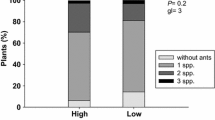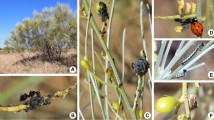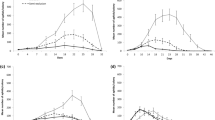Summary
Oleander aphids, (Aphis nerii), which are sporadically tended by ants, were used as a moded system to examine whether host plant factors associated with feeding site influenced the formation of ant-aphid associations. Seasonal patterns of host plant utilization and association with attendant ants were examined through bi-weekly censuses of the aphid population feeding on thirty ornamental oleander plands (Nerium oleander) in northern California in 1985 and 1986. Colonies occurred on both developing and senescing plant terminals, including leaf tips, floral structures, and pods. Aphids preferentially colonized leaf terminals early in the season, but showed no preference for feeding site during later periods. Argentine ants (Iridomyrmex humilis) occasionally tended aphid colonies. Colonies on floral tips were three to four times more likely to attract ants than colonies on leaf tips, even though the latter frequently contained more aphids. Ants showed a positive recruitment response to colonies on floral tips, with a significant correlation between colony size and number of ants. There was no recruitment response to colonies on leaf tips. These patterns were reproducible over two years despite large fluctuations in both aphid population density and ant activity. In a laboratory bioassay of aphid palatability, the generalist predator,Hippodamia convergens, took significantly more aphids reared on floral tips compared to those reared on leaf tips. The patterns reported here support the hypothesis that tritrophic factors may be important in modifying higher level arthropod mutualisms.
Similar content being viewed by others
References
Addicott JF (1978) Competition for mutualists: aphids and ants. Can J Zool 56:2093–2096
Aplin TEH (1976) Poisonous Garden Plants and Other Plants Harmful to Man in Australia. Western Australian Department of Agriculture, Bulletin 3964. 58 pp
Altieri MA, Annamalae S, Katiyar KP, Flath RA (1982) Effects of plant extracts on the rates of parasitization ofAnagasta kuehniella eggs byTrichogramma pretiosum under greenhouse conditions. Entomophaga 27:431–438
Barbosa P, Letourneau DK (1988) Novel Aspects of Insect-Plant Interactions. John Wiley and Sons, New York
Bishop YM, Fienberg SE, Holland PW (1975) Discrete Multivariate Analysis: Theory and Practice. MIT Press, Cambridge
Bodenheimer FS, Swirski E (1957) The Aphidoidea of the Middle East. Weizmann Science Press of Israel, Jerusalem
Botha CEJ, Evert RF, Walmsley RD (1975) Observations of the penetration of the phloem in leaves ofNerium oleander (Linn.) by stylets of the aphidAphis nerii (B. de F.). Protoplasma 86:309–319
Bristow CM (1984) Differential benefits from ant attendance to two species of Homoptera on New York ironweed. J Anim Ecol 53:715–726
Bristow CM (1991) Why are so few aphids ant-tended? In: Cutler DF, Huxley C (eds) Ant/Plant Interactions. Oxford University Press (in press)
Brower LP, Seiber JN, Nelson CJ, Lynch SP, Tuskes PM (1982) Plant-determined variation in the cardenolide content, thinlayer chromatography profiles and emetic potency of monarch butterflies,Danaus plexippus, reared on the milkweed,Asclepias eriocarpa, in California. J Chem Ecol 8:579–633
Buckley R (1987) Ant-plant-Homopteran interactions. Adv Ecol Res 16:53–85
Cavill GWK, Robertson PL, Davies NW (1979) An Argentine ant aggregation factor. Experientia 35:889–890
Cushman JH, Addicott JF (1989) Intra-and interspecific competition for mutualists: ants as a limited and limiting resource for aphids. Oecologia 79:315–321
Cushman JH, Whitham TG (1989) Conditional mutualism in a membracid-ant association: temporal, age-specific, and density-dependent effects. Ecology 70:1040–1047
Deneubourg JL, Aron S, Goss S, Pasteels JM (1990) The selforganizing exploratory pattern of the Argentine ant. J Insect Behav 3:159–168
Dixon AFG (1985) Aphid Ecology. Blackie, Glasgow, London
Ewart WH, Metcalf RL (1956) Preliminary studies of sugars and amino acids in the honeydews of five species of coccids feeding on citrus in California. Ann Entomol Soc Am 49:441–447
Flanders SE (1951) The role of the ant in the biological control of Homopterous insects. Can Entomol 83:93–98
Fuller TC, McClintock E (1986) Poisonous Plants of California. California Natural History Guides, 53. University of California Press, Berkeley
Greene E (1989) A diet-induced developmental polymorphism in a caterpillar. Science 243:643–646
Groeters FR (1989) Geographic and clonal variation in the milkweed-oleander aphid,Aphis nerii (Homoptera: Aphididae), for winged morph production, life history, and morphology in relation to host plant permanence. Evol Ecol 3:327–341
Hall GD, Langenheim JH (1986) Within-tree spatial variation in the leaf monoterpenes ofSequoia sempervirens. Biochem Syst Ecol 14:625–632
Hall RW, Ehler LE (1980) Population ecology ofAphis nerii on oleander. Environ Entomol 9:338–344
Hawkins BA, Browning HW, Smith Jr. JW (1987) Field evaluation ofAllorhogas pyralophagus imported into Texas for biological control of the stalkborer,Eoreuma loftini, in sugar cane. Entomophaga 32:483–491
Hinton HE (1951) Myrmecophilous Lycaenidae and other Lepidoptera—a summary. Proc Trans South Lond Entomol Nat Hist Soc (1949–50), pp 111–175
Holldobler B, Wilson EO (1990) The Ants. The Belknap Press of Harvard University Press. Cambridge, MA
Hua LZ, Lammers F, van Lenteren JC, Huisman PWT, van Vianen A, de Ponti OMB (1987) The parasite-host relationship betweenEncarsia formosa Gahan andTrialeurodes vaporariorum (Westwood): XXV. Influence of leaf structure on the searching activity ofEncarsia formosa. J Appl Entomol 104:297–304
Ismail II, Swailem SM (1971) Seasonal occurrence ofAphis nerii Boyer in Giza region (Egypt). Bull Soc Entomol Egypte 55:231–238
Janzen DH (1978) Cicada (Diceroprocta apache (Davis)) mortality by feeding onNerium oleander. Pan-Pac Entomol 54:69–70
Klingauf FA (1987) Feeding, adaptation, and excretion. In: Minks AK, Harrewijn P (eds) Aphids: their Biology, Natural Enemies, and Control. vol. A. Elsevier, Amsterdam pp 225–253
Krombein KV (1951) Wasp visitors of tulip-tree honeydew at Dunn-Loring, Virginia. Ann Ent Soc Am 41:141–143
Lawton JH, McNeill S (1979) Between the devil and the deep blue sea: on the problem of being a herbivore. In: Anderson RM, Turner BD, Taylor LR (eds) Populations Dynamics. Blackwell, Oxford. pp 223–244
Malcolm SB (1986) Aposematism in a soft-bodied insect: a case for kin selection. Behav Ecol Sociobiol 18:387–393
Malcolm SB (1990) Chemical defence in chewing and sucking insect herbivores: plant-derived cardenolides in the monarch butterfly and oleander aphid. Chemoecol 1:12–21
Mattson WJ (1980) Herbivory in relation to plant nitrogen content. Ann Rev Ecol Syst 11:119–161
McLain DK, Shure DJ (1985) Host plant toxins and unpalatability ofNeacoryphus bicrucis. Ecol Entomol 10:291–298
McNeil JN, Delisle J, Finnegan RJ (1977) Inventory of aphids on seven conifer species in association with the introduced red wood antFormica lugubris (Hymenoptera: Formicidae). Can Entomol 109:1199–1202
Molyneux RJ, Campbell BC, Dreyer DL (1990) Honeydew analysis for detecting phloem transport of plant natural products. J. Chem. Ecol. 16:1899–1909
Nixon GEJ (1951) The Association of Ants with Aphids and Coccids. Commonwealth Instit Entomol Lond. 36 pp
Nordlund DA, Chalfant RB, Lewis WJ (1985) Response ofTrichogramma pretiosum females to volatile synomones from tomato plants. J Ent Sci 20:372–376
Pierce NE, Elgar MA (1985) The influence of ants on host plant selection byJalmenus evagoras, a myrmecophilous lycaenid butterfly. Behav Ecol Sociobiol 16:209–222
Price PW, Bouton CE, Gross P, McPheron BA, Thompson JN, Weis AE (1980) Interactions among three trophic levels: influence of plants on interactions between insect herbivores and natural enemies. Ann Rev Ecol Syst 11:41–65
Rothschild M, von Euw J, Reichstein T (1970) Cardiac glycosides in the oleander aphidAphis nerii. J Insect Physiol 16:1191–1195
Siegel S (1956) Nonparametric Statistics for the Behavioral Sciences. McGraw-Hill Book Company, New York
Smiley JT, Horn JM, Rank NE (1985) Ecological effects of salicin at three trophic levels: new problems from old adaptations. Science 229:649–651
Smith HS, Armitage HM (1931) The biological control of mealybugs attacking citrus. Calif Agric Exp Station Bull 509:1–74
Sokal RR, Rohlf FJ (1969) Biometry. W.H. Freeman and Company. San Francisco
Sudd JH (1983) The distribution of foraging wood-ants (Formica lugubris Zett.) in relation to the distribution of aphids. Insectes Sociaux, Paris 30:298–307
Thorpe KW, Barbosa P (1986) Effect of consumption of high and low nicotine tobacco byManduca sexta on survival of the gregarious endoparasitoidCotesia congregata. J Chem Ecolo 12:1329–1337
Way WJ (1963) Mutualism between ants and honeydew-producing Homoptera. Ann Rev Entomol 8:307–344
Ward PS (1987) Distribution of the introduced Argentine ant (Iridomyrmex humilis) in natural habitats of the lower Sacramento Valley and its effects on the indigenous ant fauna. Hilgardia 55:1–16
Yamauchi T, Abe T, Tachibana Y, Atal CK, Sharma BM, Imre Z (1983) Quantitative variations in the cardiac glycosides of oleander. Phytochemistry 22:2211–2214
Zoebelein G (1956a) Der Honigtau als Nahrung der Insekten. Teil I. Z. Ang Entomol 38:369–416
Zoebelein G (1956b) Der Honigtau als Nahrung der Insekten. Teil II. Z Ang Entomol 39:129–167
Zoebelein G (1957) Die Rolle des Waldhonigtaus im Nahrungshaushalt forstlich nutzlicher Insekten. Forstwissenschafliches Zentralblatt 76:24–34
Author information
Authors and Affiliations
Rights and permissions
About this article
Cite this article
Bristow, C.M. Are ant-aphid associations a tritrophic interaction? Oleander aphids and Argentine ants. Oecologia 87, 514–521 (1991). https://doi.org/10.1007/BF00320414
Received:
Accepted:
Issue Date:
DOI: https://doi.org/10.1007/BF00320414




